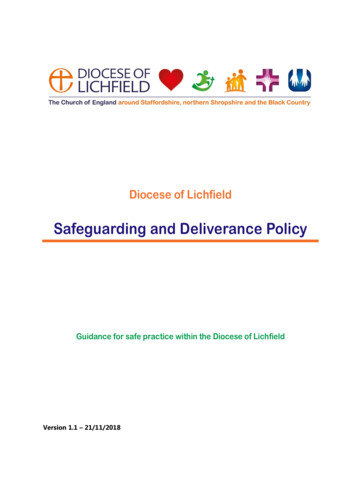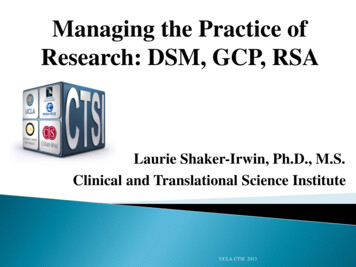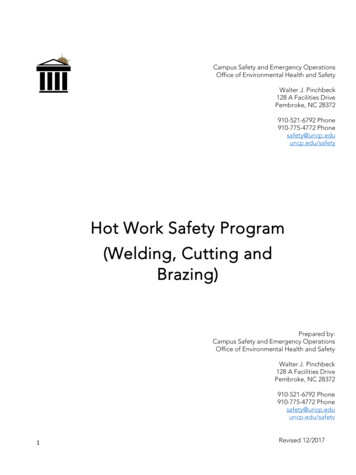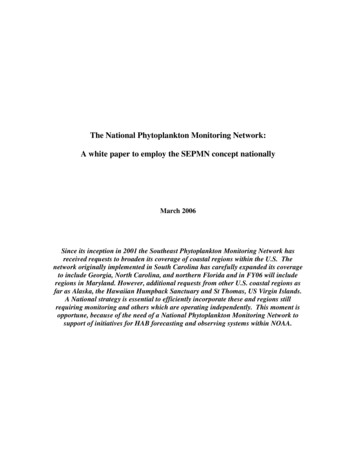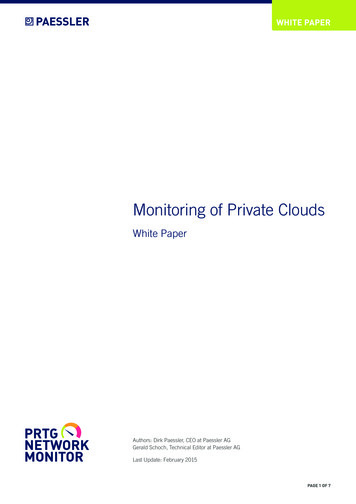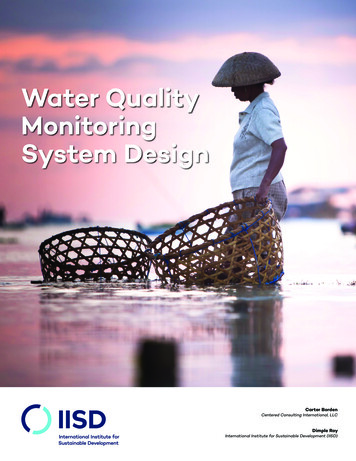
Transcription
WHO guidelines onsafety monitoring of herbal medicinesin pharmacovigilance systemsWorld Health OrganizationGeneva2004
ContentsContentsForeword . vAcknowledgements .viiPart I WHO Guidelines on safety monitoring of herbal medicines inpharmacovigilance systems1. General introduction . 11.1Introduction . 11.2Background . 11.3Objectives . 51.4Glossary . 52. Pharmacovigilance and the WHO International Drug MonitoringProgramme . 92.1What is pharmacovigilance?. 92.2How does pharmacovigilance operate?. 103. Challenges in monitoring the safety of herbal medicines . 133.1Regulation, quality assurance and control . 133.2Appropriate use . 144. Safety monitoring of herbal medicines . 174.1Sources of reports. 174.2Herbal products targeted for safety monitoring. 194.3Reporting of suspected adverse reactions . 194.4Assessment of case reports . 224.5Data management . 255. Communication . 275.1General. 275.2Risk communication . 286.References. 297. Selected bibliography . 31Safety monitoring and pharmacovigilance . 31Regulation of herbal medicines/traditional medicines. 31Quality assurance/control of herbal medicines . 32Rational use of herbal medicines . 32Annex 1: List of participants in the WHO Consultation on Safety Monitoring ofHerbal Medicines, Vancouver, Canada, 1–3 February 2004 . 33Annex 2: The Erice Declaration on Communicating Drug Safety Information,1997 . 37iii
WHO guidelines on safety monitoring of herbal medicines in pharmacovigilance systemsAnnex 3: Privacy and the confidentiality of personal health data. 39Annex 4: Spontaneous reports from persons other than health-careprofessionals . 41Annex 5: Model reporting form. 45Annex 6: Proposed database management and classification for coding herbalproducts (the Uppsala Monitoring Centre, Uppsala, Sweden) . 47Part II Safety monitoring of medicinal products: Guidelines for setting up andrunning a pharmacovigilance centre (The Uppsala Moniroring Centre,Uppsala, Sweden, 2000iv
ForewardForewordThe use of herbal medicines continues to expand rapidly across the world. Manypeople now take herbal medicines or herbal products for their health care indifferent national health-care settings. However, mass media reports of adverseevents tend to be sensational and give a negative impression regarding the use ofherbal medicines in general rather than identifying the causes of these events,which may relate to a variety of issues. The safety of herbal medicines hasbecome a major concern to both national health authorities and the generalpublic.The World Health Organization (WHO) received an urgent request from itsMember States, through the national pharmacovigilance centres participating inthe WHO International Drug Monitoring Programme and drug regulatoryauthorities, to assist Member States to strengthen national capacity in monitoringthe safety of herbal medicines and in analysing the causes of adverse events, andto share safety information at national, regional and global levels. Theseguidelines have been developed as WHO’s immediate response to this request,and to support Member States’ efforts in this area in the context of the WHOInternational Drug Monitoring Programme, which has been in operation sincethe 1970s. Thus, development of the guidelines has been carried out as a jointproject between the Traditional Medicine Team (TRM) and the Quality, Safety:Medicines Team (QSM) in the Department of Essential Drugs and MedicinesPolicy (EDM) at WHO headquarters.The recommended approach is to include herbal medicines in existing nationalpharmacovigilance systems or, where such systems have not yet been developed,to establish comprehensive national pharmacovigilance systems whichincorporate coverage of herbal medicines. As described in the Introduction to theguidelines, it is not WHO’s intention to suggest that different systems should beinstituted for this purpose. However, in view of the unique characteristics of theprovision and use of herbal medicines, there are several technical issues thatneed to be addressed if adequate and effective monitoring is to be introduced.The guidelines therefore identify the particular challenges posed in monitoringthe safety of herbal medicines effectively and propose approaches forovercoming them. Special attention is also given to the reporting system foradverse reactions to herbal medicines, and to the analysis of the causes of thereported adverse reactions.In order to handle herbal medicines, in particular, to analyse the causes ofadverse events, national pharmacovigilance centres (or equivalent institutions)will need to acquire specific technical expertise. This will include trainedpersonnel in relevant technical areas and facilities to analyse the productsconcerned, for which there is often insufficient information and lack of access toreliable information support. Many countries currently lack this expertise, inparticular, access to suitable analytical laboratories. Member States havetherefore recommended the establishment of regional laboratories specializing inv
WHO guidelines on safety monitoring of herbal medicines in pharmacovigilance systemsthe analysis of herbal products. WHO encourages Member States to explore thefeasibility of this proposal.To further the implementation of these guidelines, WHO plans to organize aseries of training workshops for Member States, in collaboration with the WHOCollaborating Centres for International Drug Monitoring and for TraditionalMedicine. National capacity in monitoring the safety of herbal medicines will befurther strengthened through national training workshops on topics such as,broadening reporting schemes, acquiring technical expertise at nationalpharmacovigilance centres, and promoting awareness. Training of practitionerswho provide herbal medicines will also be crucial.The guidelines also articulate technical issues relating to data management andcommunication. The Uppsala Monitoring Centre, Uppsala, Sweden (UMC) hasproposed the herbal anatomical-therapeutic-chemical classification (HATC) as acoding tool to permit the inclusion of individual herbal products in the globalWHO database of adverse drug reaction (ADR) reports for pharmacovigilancepurposes. The summary explanation of the proposed system by UMC is annexedto the guidelines. Although the system represents a valuable attempt at codingherbal medicines, it may not be perfect for covering all types of herbal products,in particular, traditional medicines that are used under unique concepts and withunique terminologies. Member States are encouraged to offer suggestions, on thebasis of their national experience in the day-to-day operation of nationalpharmacovigilance, as to how classification could be approached in a morecomprehensive manner and in a way that meets their national circumstances.WHO, in collaboration with UMC, will work with Member States to continuedevelopment of the system.Currently, the majority of adverse events related to the use of herbal productsand herbal medicines that are reported are attributable either to poor productquality or to improper use. Inadequate regulatory measures, weak quality controlsystems and largely uncontrolled distribution channels (including mail order andInternet sales) may have been contributing to the occurrence of such events. Inorder to expand knowledge about genuine adverse reactions to herbal medicines,and to avoid wasting scare resources for identifying and analysing adverseevents, events resulting from such situations will need to be reduced oreliminated. Member States are therefore encouraged to strengthen nationalregulation, registration and quality assurance and control of herbal medicines. Inaddition, national health authorities should give greater attention to consumereducation and to qualified practice in the provision of herbal medicines.WHO has welcomed the active participation of drug regulatory authorities andnational pharmacovigilance centres, among others, in the development of theseguidelines. This has provided a useful starting point for strengtheningcommunication between these authorities, which will be needed to ensureprogress towards the common goal – the safety of herbal medicines.Dr Xiaorui ZhangCoordinator, Traditional MedicineDepartment of Essential Drugs and Medicines PolicyWorld Health Organizationvi
AcknowledgementsAcknowledgementsThe World Health Organization (WHO) wishes to express its sincereappreciation to Health Canada, in particular the Natural Health ProductsDirectorate, for kindly hosting the WHO Consultation on Safety Monitoring ofHerbal Medicines in Vancouver, Canada, in February 2004 (Annex 1), with itsfinancial support.WHO also wishes to thank the Ministry of Health, Welfare and Sports,Netherlands for its generous financial contribution to WHO in support of theWHO Working Group Meeting on Safety Monitoring and Pharmacovigilance ofHerbal Medicines held in Amsterdam, Netherlands in October 2002, and theWHO Consultation on Safety Monitoring of Herbal Medicines held inVancouver, Canada, in February 2004. Special thanks are extended to Dr Keesvan Grootheest, Director, Netherlands Pharmacovigilance Foundation (LAREB),and his team, for their assistance in organizing the 2002 meeting.WHO acknowledges the valuable contribution of Dr Ralph Edwards, Director,WHO Collaborating Centre for International Safety Monitoring at the UppsalaMonitoring Centre, Uppsala, Sweden, and his team, and Professor DavidCoulter, Intensive Medicines Monitoring Programme, Department of Preventiveand Social Medicine, School of Medicine, University of Otago, Dunedin, NewZealand, to the preparation of the draft guidelines.The Organization is grateful to the participants in the two consultative meetingsfor their work in reviewing the draft guidelines. Thanks are also due to the morethan 400 experts in over 102 countries, including those at the nationalpharmacovigilance centres participating in the WHO International DrugMonitoring Programme, national drug regulatory authorities, poisons centresand national health authorities, as well as, WHO Collaborating Centres forTraditional Medicines, and members of WHO Advisory Panel on TraditionalMedicines, who reviewed and provided comments and advice on the draftguidelines. Preparation of the guidelines has also benefited from technicalsupport from relevant international and nongovernmental organizations,including associations of health professions and of manufacturers of herbalmedicines, and consumer associations.Finally, WHO expresses its appreciation to The Council for InternationalOrganizations of Medical Sciences and the Uppsala Monitoring Centre, Uppsala,Sweden for permission to reproduce the material included in Annexes 3 and 4,and Part II of the guidelines, respectively.vii
Part IWHO Guidelines on safety monitoring of herbal medicines inpharmacovigilance systems
General introduction1. General introduction1.1IntroductionSafety is a fundamental principle in the provision of herbal medicines and herbalproducts for health care, and a critical component of quality control. Theseguidelines provide practical technical guidance for monitoring the safety ofherbal medicines within pharmacovigilance systems. The safety monitoring ofherbal medicines is compared and contrasted with that of other medicinescurrently undertaken in the context of the WHO International Drug MonitoringProgramme. While there are regulatory and cultural differences in thepreparation and use of different types of medicines, they are all equallyimportant from a pharmacovigilance perspective.The guidelines were developed with the view that, within currentpharmacovigilance systems, monitoring of the safety of medicines should beenhanced and broadened in ways that will allow the successful monitoring ofherbal medicines. It is not the intention to suggest that different systems shouldbe instituted for this purpose. The guidelines should therefore be considered inconjunction with the publication entitled, Safety monitoring of medicinal products:guidelines for setting up and running a pharmacovigilance centre (1), which isreproduced as Part II of this publication.The inclusion of herbal medicines in pharmacovigilance systems is becomingincreasingly important given the growing use of herbal products and herbalmedicines globally. For example, in the United States of America, some US 17billion was spent by more than 158 million Americans in 2000 (2). Further, arecent study indicated that more than 70% of the German population reportedusing “natural medicines” and that, for most of them, herbal medicinal productswere the first choice in the treatment of minor diseases or disorders (3). Theworldwide consumption of herbal medicines is enormous, so that, in terms ofpopulation exposure alone, it is essential to identify the risks associated withtheir use. Safety of herbal medicines is therefore an important public health issue.Herbal medicines are frequently used in conjunction with other medicines, and itis essential to understand the consequences of such combined use and monitorwhether any adverse effects are arising. This can be achieved most readily withinexisting pharmacovigilance systems.1.2BackgroundProblemsAmong consumers, there is a widespread misconception that “natural” alwaysmeans “safe”, and a common belief that remedies from natural origin areharmless and carry no risk. However, some medicinal plants are inherently toxic.1
WHO guidelines on safety monitoring of herbal medicines in pharmacovigilance systemsFurther, as with all medicines, herbal medicines are expected to have side effects,which may be of an adverse nature. Some adverse events reported in associationwith herbal products are attributable to problems of quality. Major causes of suchevents are adulteration of herbal products with undeclared other medicines andpotent pharmaceutical substances, such as corticosteroids and non-steroidal antiinflammatory agents. Adverse events may also arise from the mistaken use of thewrong species of medicinal plants, incorrect dosing, errors in the use of herbalmedicines both by health-care providers and consumers, interactions with othermedicines, and use of products contaminated with potentially hazardoussubstances, such as toxic metals, pathogenic microorganisms and agrochemicalresidues.The following examples demonstrate the range of problems encountered with theuse of herbal medicines and products. Some herbal products were found to contain 0.1–0.3 mg of betamethasone percapsule after some patients developed corticosteroid-like side effects.Owing to misidentification of the medicinal plant species, plant materialscontaining aristolochic acid were used for manufacturing herbal products,which caused severe kidney failure in patients in several countries.Reports have been received by drug safety monitoring agencies of prolongedprothrombin times, increased coagulation time, subcutaneous haematomasand intracranial haemorrhage associated with the use of Ginkgo biloba.One of the most well known traditionally used herbal medicines causedsevere, sometimes fatal cases of interstitial pneumonia when used inconjunction with interferon.Adverse events thus far reported in relation to herbal products are frequentlyattributable either to poor quality or to improper use, and it is therefore difficultto distinguish genuine adverse reactions to herbal medicines and herbal productsuntil the cause of such events has been identified.Current situationDespite the growing interest in the safety of herbal medicines, nationalsurveillance systems to monitor and evaluate adverse reactions associated withherbal medicines are rare, even among the more than 70 Member Statesparticipating in the WHO International Drug Monitoring Programme. Moreover,there is a lack of effective communication on this subject at all levels, frominternational to local. A recent WHO survey showed that around 90 countries,less than half of WHO’s Member States, currently regulate herbal medicines, andan even smaller proportion has systems in place for the regulation/qualificationof providers of herbal medicines. Moreover, there are disparities in regulationbetween countries, and this has serious implications for international access toand distribution of such products.National pharmacovigilance systems should be closely linked to national drugregulatory systems. To function properly, a national safety monitoringprogramme for herbal medicines should be operated alongside an effectivenational drug regulatory system with the will and the potential to react to signalsemanating from reports of adverse effects of herbal medicines and to take properregulatory measures.2
General introductionAt the national level, the capacity for reporting adverse events on herbalmedicines, analysing their causes and learning from past experience is seriouslyhampered in many Member States by the lack of methodological uniformity inidentification and measurement, the lack of information on adverse effects ofherbal medicines, inadequate reporting schemes, fear of professional liability,and inadequate information systems relating to the use of herbal medicines.Current knowledge of the epidemiology of adverse reactions to herbal medicines,such as frequency of occurrence and causes, is very limited.Action requiredFor the safety of those using herbal medicines, four complementary actions areneeded: clear identification of the nature of adverse eventsmanagement of the risksinstitution of measure to prevent adverse eventsgood communication of the risks and benefits of herbal medicines.These require: increased ability to learn from identified adverse events through betterreporting systems, skilful technical investigation of incidents and responsiblesharing of datagreater capacity to anticipate adverse events and to probe systemicweaknesses that might lead to problemsidentification of existing knowledge resources, within and outside the healthsectorimprovements in the health-care delivery system, so that structures arereconfigured, incentives are realigned, and safety and quality are placed atthe core of the systemIn 2000 and 2001, the annual meetings of national pharmacovigilance centresparticipating in the WHO International Drug Monitoring Programme requestedWHO to provide urgent support to Member States in developing nationalsystems for the safety monitoring of herbal and traditional medicines. This wasechoed by a recommendation made at the Third WHO Consultation on SelectedMedicinal Plants, and at the WHO Informal Meeting on Methodologies forQuality Control of Finished Herbal Products, both held in Ottawa, Canada, inJuly 2001. The International Conference of Drug Regulatory Authorities (ICDRA)also made recommendations to WHO in 1999 and 2002 that it should supportMember States in strengthening their capacity in these areas. In addition,resolution WHA56.31 on traditional medicine, adopted at the Fifty-Sixth WorldHealth Assembly in May 2003, urged Member States to set up or expand andstrengthen existing national drug safety monitoring systems to monitor herbalmedicines and other traditional practices.Action needed by WHO to respond to these requests includes: provision of technical guidance to facilitate the expansion of existing systemsto monitor and report adverse drug reactions to herbal medicines or theestablishment of comprehensive national drug safety monitoring systems that3
WHO guidelines on safety monitoring of herbal medicines in pharmacovigilance systems incorporate the safety monitoring of herbal medicines, where these do not yetexistsupport to countries in strengthening their pharmacovigilance system forherbal medicines, allowing for the involvement of health-care providers,consumers and manufacturers.WHO has taken the lead in tackling the need for drug safety monitoring since1970 (resolution WHA23.13 on international monitoring of adverse reactions todrugs, 1970). The WHO International Drug Monitoring Programme, togetherwith the WHO Collaborating Centre in Sweden, the Uppsala Monitoring Centre(UMC), has instituted a coherent programme of action for pharmacovigilance,which includes the establishment of a programme for exchange of safetyinformation, maintenance of the global WHO database of adverse drug reaction(ADR) reports (hereafter referred to as the global WHO database), and theprovision of numerous guidelines on monitoring drug safety. It also seeks tobridge the gap between industry and regulatory authorities. As an immediateresponse to the need for pharmacovigilance for herbal medicines, WHO hasincreased its efforts to promote their safety monitoring within the context of theWHO International Drug Monitoring Programme.Where there is a national drug safety monitoring system in place, there is a clearneed to expand its scope to include herbal medicines. If no such system exists,there is an urgent need to establish such a system, which should includemonitoring of herbal medicines. However, adding herbal medicines to a list oftarget substances for a national drug safety monitoring activities is not enough initself. Because of the particular nature of the distribution and use of herbalmedicines, adequate and effective monitoring demands special requirements,including: 4expanding the source of case reports, for example by:– involving all providers of herbal medicines, including providers oftraditional medicine and complementary/alternative medicine, accordingto national circumstances– strengthening the role of providers, such as pharmacists and health-careprofessionals, working in the community– involving manufacturers of herbal medicines– facilitating consumer reporting– developing systems of information exchange involving drug informationcentres, poisons centres, consumer organizations and manufacturersestablishing a system for the exchange of regulatory and quality informationon herbal medicines among national pharmacovigilance centres and nationaldrug regulatory authoritiesstrengthening capacity to carry out monitoring of herbal medicines atnational pharmacovigilance centres by:– training staff in relevant technical areas– ensuring access to facilities for analysing products suspected of causingadverse reactions– providing access to reliable informationdeveloping a standard classification and/or coding system for herbalmedicines, with standardized terms and definitionsstrengthening communication and awareness at all levels (global, regional,national, local and community) and among key players (international bodies,
General introductionregulatory authorities, national pharmacovigilance centres, health-careproviders and consumers).In response to these needs, WHO has developed these guidelines. It also plans toorganize a series of training workshops to strengthen national capacity in safetymonitoring of herbal medicines within pharmacovigilance systems in MemberStates.1.3ObjectivesThe objectives of these guidelines are to: support Member States, in the context of the WHO International DrugMonitoring Programme, to strengthen national pharmacovigilance capacity inorder to carry out effective safety monitoring of herbal medicinesprovide technical guidance on the principles of good pharmacovigilance andthe inclusion of herbal medicines in existing national drug safety monitoringsystems; and where these systems are not in place, to facilitate theestablishment of an inclusive national drug safety monitoring systemprovide standard definitions of terms relating to pharmacovigilance, andsafety monitoring of herbal medicinespromote and strengthen internationally coordinated information exchange onpharmacovigilance, and safety monitoring of herbal medicines amongMember Statespromote the safe and proper use of herbal medicines.The regulation of herbal medicines and their place in national health-caresystems differs from country to country, and these guidelines will therefore needto be adapted to meet the needs of the local situation.1.4GlossaryThe terms used in Part I of these guidelines are defined below.Terms relating to herbal medicinesThese terms and their definitions have been selected and adapted from otherWHO documents and guidelines that are widely used by the WHO MemberStates, such as the General guidelines for methodologies on research and evaluation oftraditional medicine (4). These definitions may differ from those included innational regulations, and are therefore, for reference only.Herbal medicines include herbs, herbal materials, herbal preparations and finishedherbal products. In some countries herbal medicines may contain, by tradition,natural organic or inorganic active ingredients that are not of plant origin (e.g.animal and mineral materials).5
WHO guidelines on safety monitoring of herbal medicines in pharmacovigilance systemsHerbs include crude plant material, such as leaves, flowers, fruit, seeds,stems, wood, bark, roots, rhizomes or other plant parts, which may be entire,fragmented or powdered.Herbal materials include, in addition to herbs, fresh juices, gums, fixed oils,essential oils, resins and dry powders of herbs. In some countries, thesematerials may be processed by various local procedures, such as steaming,roasting or stir-baking with honey, alcoholic beverages or other materials.Herbal preparations are the basis for finished herbal products and may includecomminuted or powdered herbal materials, or extracts, tinctures and fattyoils of herbal materials. They are produced by extraction, fractionation,purification, concentration, or other physical or biological processes. Theyalso include preparations made by steeping or heating herbal materials inalcoholic beverages and/or honey, or in other materials.Finished herbal products consist of herbal preparations made from one or moreherbs. If more than one herb is used, the term “mixture herbal product” canalso be used. Finished herbal products and mixture herbal products maycontain excipients in addition to the active ingredients. However, finishedproducts or mixture herbal products to which chemically defined activesubstances have been added, including synthetic compounds and/orisolated constituents from herbal materials, are not considered to be herbal.Traditional use of herbal medicines refers to the long historical use of thesemedicines. Their use is well established and widely acknowledged to be safe andeffective, and may be accepted by national authorities.Therapeutic activity refers to the successful prevention, diagnosis and treatmentof physical and mental illnesses. Treatment includes beneficial alteration orregulation of the physical and mental status of the body and development of asense of general well-being as well as improvement of symptoms.Active ingredients refer to ingredients of herbal medicines with therapeuticactivity. Where the active ingredients have been identified, the preparation of thefinished herbal product should be standardized to ensure that it always containsa defined amount of the active ingredients, providing adequate analyticalmethods are available. In cases where it is not possible to identify the activeingredients, the whole herbal medicine may be considered as one activeingredient.Traditional med
the safety of herbal medicines effectively and propose approaches for overcoming them. Special attention is also given to the reporting system for adverse reactions to herbal medicines, and to the analysis of the causes of the reported adverse reactions. In order to handle herbal medicines, in particular, to analyse the causes of





